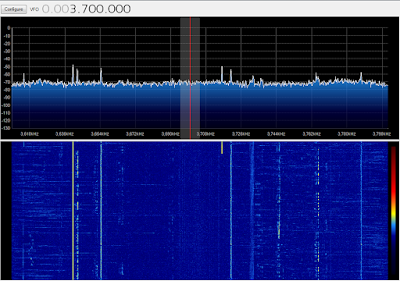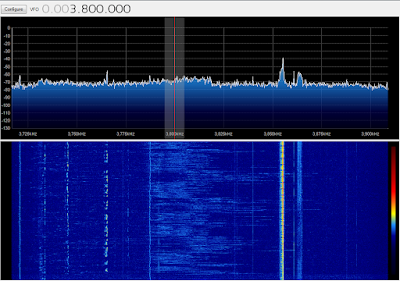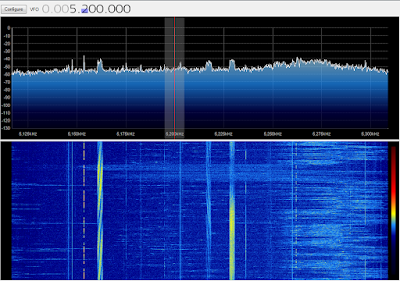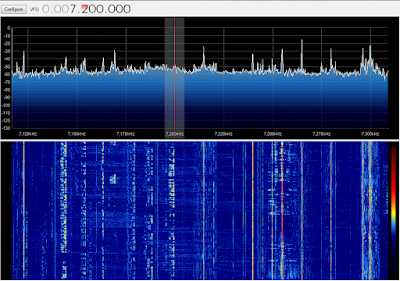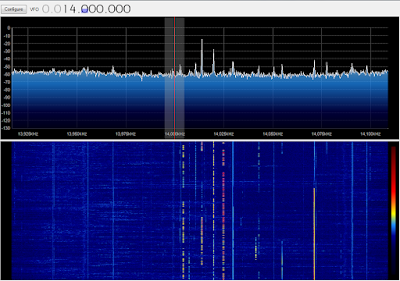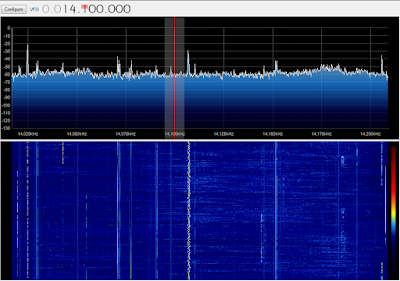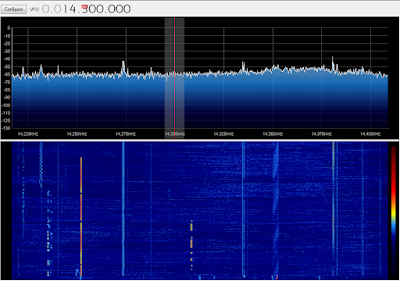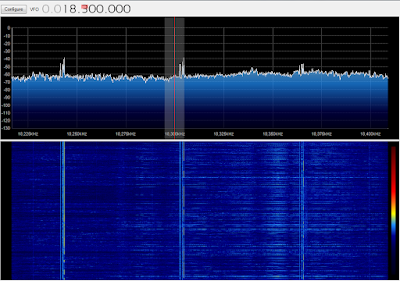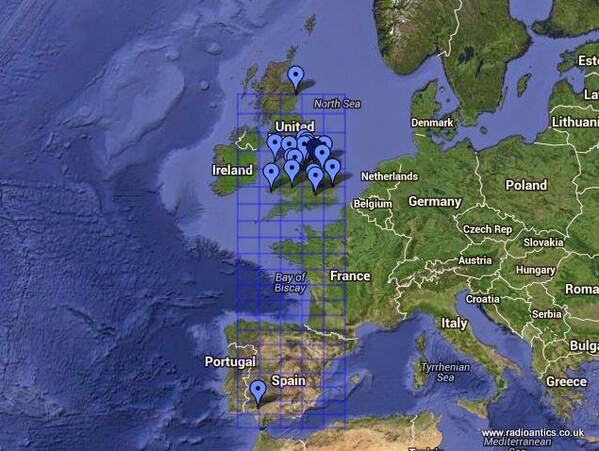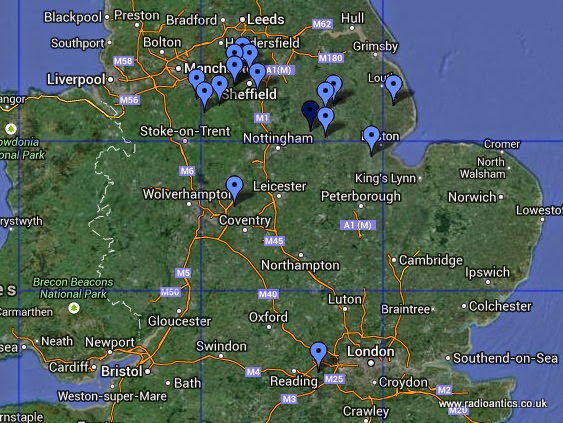Posts Tagged ‘QRM’
 PLT Devices – Have I welcomed the Devil in to the shack?
PLT Devices – Have I welcomed the Devil in to the shack?
I need to set up the ability to remotely operate the station via the internet as well as experiment with internet linking systems but the wi-fi link to the shack isn't fast or reliable enough. Now if I do a scan looking for wi-fi networks I can see well over a dozen, some of them quite strong and more are popping up all the time and I suspect this congestion is part of my problem.
The Samsung Smart TV in the house was also wi-fi linked but we were having increasing issues with the BBC iPlayer and Netflix with buffering or poor quality images because of poor signal and data rates.
Ideally I would be like to fit proper ethernet cables but it is totally impractical without major upheaval or unsightly trunking a definite no-no. In the end the only workable and affordable solution seemed to be to get some of those evil Powerline Transmission (PLT) devices.
I have suffered strong sporadic QRM myself which I have assumed were neighbours PLT networking devices as I'd read the horror stories, seen the videos and anecdotal reports of mains borne noise caused by them. So I hadn't even considered it until I saw a post and video by Dan Trudgian (M0TGN) about his experiences of using some Netgear devices and the apparant lack of interference to his radio activities. Some members of South Kesteven ARS had also started using them, so I took the plunge and ordered some Netgear ones reduced on Amazon in the Boxing Day sales.
Setting them up was easy, but the acid test was how much noise did they generate? I set up one device in the shack at the far end of the mains cable run to maximise radiation. Streaming internet radio and a HD movie on Netflix I then used the FUNCube Dongle PRO+ SDR connected to the OCFD to see what noise they were generating.
Here are my observations going through the various HF bands. Where noise is present I first stopped the streaming and then powered off the devices to eliminate them as the cause, where they were the cause it seemed eliminating the network traffic was sufficient to greatly reduce the effect.
80 Meters
While the antenna isn't optimised for 80m, signals can be seen as well as noise. Before you get excited this noise has been present for quite a while and isn't being caused by the new Netgear devices. This noise is what I suspected was generated by PLT devices used by my neighbours.
60 Meters
Shocking noise but again this isn't caused by my new devices, the noise has the same characteristics as that seen on 80m.
40 Meters
The band was busy, there is some noise again but not from the new devices, this was looking encouraging. I have also showed the adjacent broadcast band.
30 Meters
Again, largely noise free
20 Meters
Still largely noise free, the QRM that is present still wasn't due to the new devices
17 Meters
This was the first indication of QRM from the new devices, however it appears effectively filtered to leave the amateur allocation clear. The faint noise in the middle picture is not from the new devices.
15 Meters
Again this band was clear of noise
12 Meters
Showing the two ends of the band again the clear signal/noise from the devices again seems effectively filtered
10 Meter
I didn't observe any additional noise on this band, but unfortunately deleted the screen grabs ;-)So where was the QRM?
While the amateur bands appear to be filtered, the transmission can of course can clearly be seen on some non-amateur bands and apart from 16 meters seems to avoid the broadcast bands.
Conclusion
These Netgear XAVB5221 devices seem effective, indeed doing a speedtest in the shack was more than acceptable (the dire upload speed is a 'feature' of my cable ISP)This fairly rudimentary testing has largely given me confidence that they won't be any issues. The band conditions weren't brilliant when I did test, but even with the absence of signals on the band any noise would be evident as seen. Yes they clearly do generate QRM but thankfully not it seems in the amateur bands. I haven't heard any extra noise on any of the radios over the last few days so all is looking promising. I will keep you posted if there is any change.
 OFCOM undue interference consultation
OFCOM undue interference consultation
2015 has started with some important developments. Ofcom have launched a consultation on draft regulations for new wireless telegraphy legislation. The proposals are intended to strengthen regulatory power and keep pace with technological advances with respect to interference of radio communications from electronic devices.
Current Electromagnetic Compatibility (EMC) regulations should prevent electrical and electronic apparatus emitting electromagnetic energy that would cause interference to radio communications but as most licensed operators have experienced this is not the case. In particular the growth of "power line" networking equipment (PLT) in recent years has caused much distress to amateur radio particularly in populated areas. I myself have suffered interference from what I believe are PLT devices.
It is certainly true that most newer devices are much better and are notched to prevent emissions in certain bands but there are still many older devices in use and imported non-compliant devices are still readily available. It is not just PLT devices that cause issues but solar panels with RF noisy inverters, unfiltered switch mode power supplies, plasma televisions and other equipment that pollute the spectrum.
Unfortunately at present Ofcom has limited enforcement powers so are proposing the law is amended to make it a criminal offence to continue using equipment identified as a source of undue interference.
Several agencies such as GCHQ, CAA and emergency services have voiced concerns in the past over the threat of RF pollution (Telegraph newspaper article) so not surprisingly this weeks announcement has been given the 'spooks' spin with some sensationalist headlines "You could be prosecuted over your broadband thanks to GCHQ" as the Telegraph reported.
I feel it is important that UK licensed amateurs respond to these proposals and the consultation is only open till next month it is very easy to respond on line at the Ofcom website.
It is quite a timely announcement from Ofcom since I have been forced to use the QRM eliminator that I purchased back in August due to increasing interference. I have not been able to use it in line with the FT857D as it requires the PTT/TX-GND signal from the CAT/Linear socket from the transceiver to activate a bypass when transmitting. The issue being I wished to use the CAT functionality at the same time and this involved making up a harness with the appropriate 8-pin mini-DIN plug/socket. I purchased some plugs and sockets but kept putting it off due to the fiddly nature of the small connectors and I didn't wish to cause any damage to the FT857D by shorting the pins.
By chance I spotted this cable on eBay which is the same as my current CAT cable but with the addition of the PTT/TX-GND signal on a short pigtail with a phono (RCA) socket making it a breeze to complete the installation.
I am hoping to improve the noise performance by putting up a new HF antenna in the future, to this end I have had a nice Christmas present. A Feature Tech AW07A HF-VHF-UHF Antenna Analyzer
Once I have used it in anger I will post a proper report, but it seems a great piece of kit with some encouraging reviews, currently available of £168 on eBay it is a massive £200 less than the identical MFJ-266
 Noises Off – WiMo QRM Eliminator
Noises Off – WiMo QRM Eliminator
In desperation I had been looking at some of the noise cancellers available from MFJ and others. I had heard conflicting options on their effectiveness but was willing to try one if I could obtain one cheaply. The MFJ units are in my opinion expensive to purchase new so I bid on several that came up second hand on eBay but they invariably also went for silly money. I was even contemplating building an home-brew one from the numerous designs available.
Then I discovered the WiMo QRM Eliminator, made by the German company WiMo Antennas and Electronics. Several online reviews and numerous YouTube videos seemed to indicate its effectiveness and taking up the then summer discount offer I ordered one for the princely sum of €147 including postage, around £116.
Due to heavy demand and low stock levels following the International Ham Radio Exhibition at Friedrichshafen I was told the unit wouldn't be available till the middle of August, so I was pleasantly surprised when the unit turned up last Friday morning.
New toy in time for the weekend ;-) Thank you @wimo_de pic.twitter.com/4Xfuv5ccHB
— Andrew Garratt (@nerdsville) August 1, 2014 I have connected it up and briefly tried it out and am impressed, as this video illustrates.Even using one for a short time I would agree that they are something of a black art to set up and use and can understand why people might consider them useless, but this may be due to lack of understanding of how they work.
I have created a diagram showing a typical scenario.
The operators main antenna is designed to pick up distant signals, not necessarily DX but signals not emanating from the immediate vicinity, however they will also pick up locally produced QRM as shown, perhaps generated by a neighbours TV or PLT device.
The QRM eliminator has a second antenna which isn't as efficient as the main antenna and ideally just receives the local QRM at a similar level to the main antenna. The device then takes this second signal and inverts the phase so when it is mixed with the main antenna signal the QRM is cancelled out.
The principal is quite simple, if you take two in phase signals and combine them you will end up with a signal with a larger amplitude. However if the signal is 180 degrees out of phase, the positive and negatives of the waveform cancel each other, producing a null signal.
The tricky part is making sure the noise antenna just picks up the noise, if it picks up the main signal then that will also be cancelled out. The WiMo unit has three controls a gain and two phase controls it is a case of altering all three to maximise the cancelling effect without losing the main signal.
At present I just have several meters of wire running as the noise antenna along the side of the shack and this seems to fairly effective.
The unit is powered from 12V and can be left in line, but requires the PTT/TX-GND signal from the CAT/Linear socket from the transceiver to activate a bypass when transmitting and I don't have the appropriate 8-pin plug at present. If the unit is powered off the bypass is automatically engaged.
All in all, first impressions are good and looks like a worthwhile purchase.
 Noises Off!
Noises Off!
RFI is referred to as QRM or QRN and I am learning the difference.
QRM means "I being interfered with" and is interference coming from someone using radio equipment. This covers deliberate jamming, people tuning up or just normal operations on a crowded band that causes QRM.
QRN means "I am troubled by static" and technically means interference from a natural noises but has come to refer to interference coming from anything that is not an intentional radio emission and interferes with reception of transmissions. So now covers atmospheric noise, static or the noise generated by electronic devices.
Noise isn't a new issue here as I have posted before. It has tended to be sporadic and bearable but since becoming licensed I have become more sensitised to it. Until now I have tended to focus on the VHF/UHF side mainly contesting venturing only briefly onto HF.
My HF set up is limited at the moment with just a single antenna which isn't optimal for the lower bands. Due to the day job I am largely restricted to evening/night time operation when the upper bands have largely been closed anyway so haven't really attacked HF with much enthusiasm apart from data modes such as JT65 and WSPR which have immunity to noise.
When I have got the chance for some early morning daytime operation or at the weekend I have struggled with noise. Recent weekends have seen some special event stations operating for the Museums On The Air and the GB1JSS Summer Solstice which have been predominately on the 40M band but I just cannot hear anything on that band due to noise.
I am aware the Sun has been particular active recently producing a number of large flares and CMEs that have caused a number of radio blackouts, but this noise isn't due to atmospherics I am certain it is man made by one of neighbours.
I made this video last weekend
and this video was from the weekend before that
This weekend was the 50MHz Trophy Contest which I was looking forward to, sadly it was also to become a victim of the QRN as this screenshot from my SDR will confirm, for much of the time I was operating I was just listening to noise.
I wasn't operating constantly, just grabbing a few minutes here and there and I did manage to make some decent contacts when the QRN subsided even catching some of the sporadic E opening to get EF7X in Spain.
I have ruled out any noise being generated by myself by powering everything off and running on battery. This leaves me in a bit of a quandary I could go around and locate and confront the culprit or even contact OFCOM but at the same time I don't want to antagonise anyone who could then object to any antennas I might want to put up in the garden.
Rotating the 6M Moxon around at the weekend during the contest as at least pointed me in the direction of one strong noise source. I am also convince that much of my problem is due to an evil PLT device in an adjacent property.
Following on from the weekend last night was the UKAC 50MHz contest and yet again I was troubled with noise leading to mostly local contacts.
I have been looking at some of the noise cancellers that are available from MFJ and others. I have heard conflicting options on their effectiveness but I am willing to try one if I can obtain one cheaply, or even home-brew one from the numerous designs available.
These devices work by using a second antenna which receives just the noise which is then mixed out of phase with the main antenna signal hence nullifying the noise. By all accounts they are tricky to use and often need constant adjustment but may be my only viable solution at present.
 EU wil de norm voor gebruik van PLC’s verhogen
EU wil de norm voor gebruik van PLC’s verhogen
Ik heb inmiddels de petitie ondertekend.
 Intruder Alert! Intruder Alert! Lt. Worf to the Bridge!
Intruder Alert! Intruder Alert! Lt. Worf to the Bridge!
Yeah I know, I was dying to throw out a Star Trek reference all last week and couldn’t. Now I got one. But it looks like there are a couple of intruding signals on 24 and 28 MHz as a video on YouTube from New Zealand shows. Aliens? Covert Government experiments designed to make us more docile to the idea of one world order? Um, I’m thinking no.But they are a bit of a nuisance. Here are the videos so you can see for yourself.
28 MHz
24 MHz
73.
Rich also writes a Tech blog and posts stories every Tuesday and Thursday on Q103, Albany’s #1 Rock Station website, as well as Amateur Radio stories every Monday thru Friday on AmiZed Studios and hosts a podcast called The Kim & Rich Show with his fiance’ Kim Dunne.

